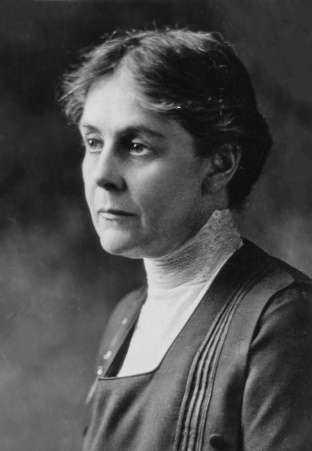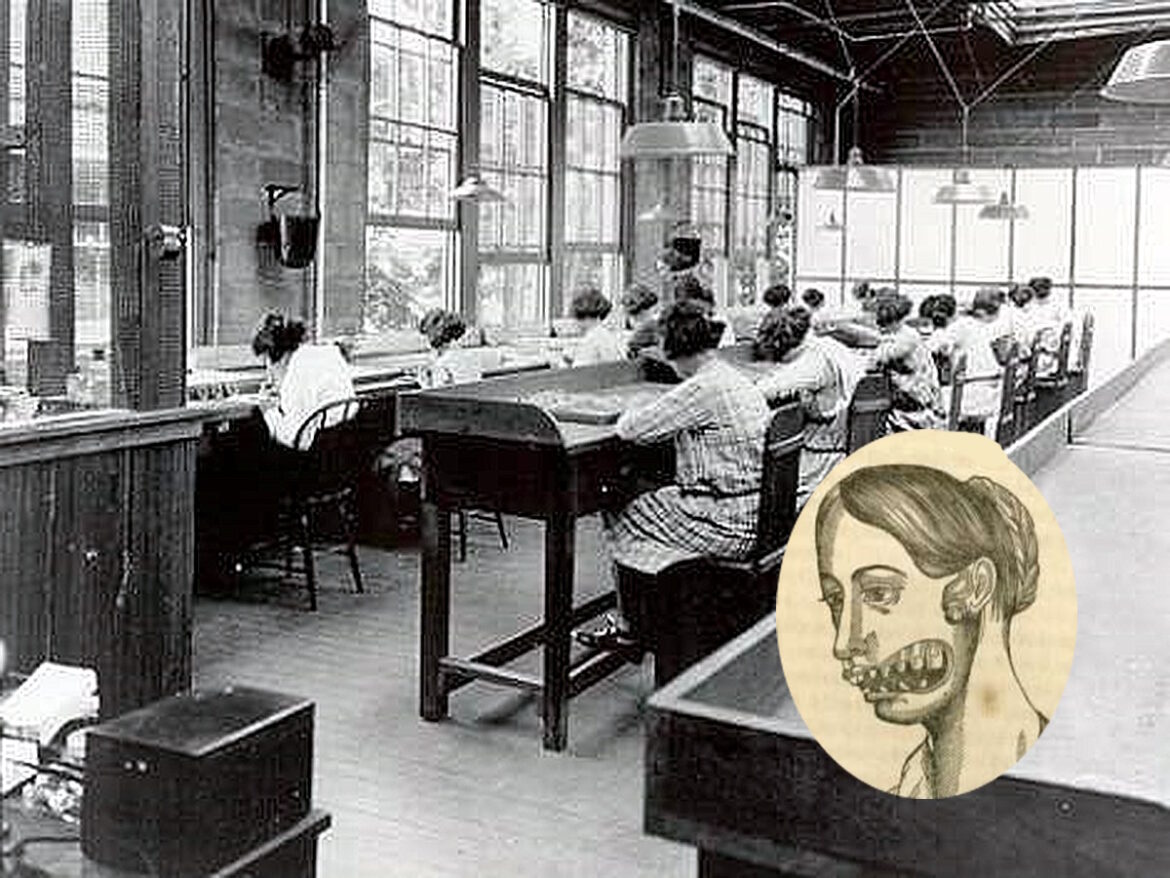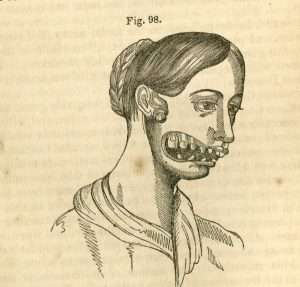Frances Splettscher was the first of the Waterbury radium girls to die. In 1921 at the age of 17, she had gone to work for the Waterbury Clock Co., painting watch dials with the new miracle substance, radium.
To get a nice, sharp point on her paintbrush, Frances, like the other radium girls, put the brush to her lips to get a nice, sharp point, dipped it into the paint and painted the dial. Then she did it again, over and over, for eight cents a dial.
The radium girls didn’t think radium carried any danger. The company told them it would give them glowing health. Wasn’t radium used to cure people?
The radium girls believed their supervisors. They painted their dress buttons with it and their fingernails, and they painted rings on their fingers.
In 1925, Frances Splettscher died of radium poisoning after an agonizing illness. She developed severe anemia, and her teeth hurt. When a dentist pulled a tooth, part of her jaw came with it. Her mouth rotted until she had a hole in her check.
She was one of hundreds of young immigrant women hired to paint luminous paint onto the popular new watch dials in Connecticut – in Waterbury, Bristol, Thomaston and New Haven – and in Orange, N.J., and in Ottawa, Ill. She was also one of dozens who died from radium poisoning.
Radium Girls
In 1920, Katherine Schaub had come to train the radium girls at the Connecticut watch studios, including the Waterbury Clock Co. She had worked as a dial painter in Orange, N.J., at the United States Radium Corporation (USRC).
Katherine later contracted radium poisoning and, with four other dial painters, sued USRC. The company settled out of court, but Katharine died at the age of 30 after suffering excruciating pain.

Waterbury Clock Co.
In 1923, U.S. Public Health Service said radium workers should take precautions. The radium girls in Waterbury knew nothing of it. A company doctor named Frederick Flinn examined them and reassured them they were fine.
What they didn’t know was that Flinn was a fraud who found a career covering up for companies that killed their workers with radium poisoning. He hadn’t gone to medical school; he had just acquired a PhD. That didn’t stop him from taking blood, reading x-rays and ordering medical treatment.
Frederick Flinn helped USRC fight the charges brought by Katherine Schaub and the other radium girls. He also worked with Waterbury Clock to sweep the radium poisoning under the rug.
Frederick Flinn
Flinn had approached Waterbury Clock Co. offering to examine the dial painters for free. By 1925, the year Frances Splettscher died, the company hired him.
That same year Elizabeth Dunn tripped slightly on a dance floor and suffered a spontaneous fracture of her leg. The radium had eaten into her bones, riddling them with holes. She developed the same jaw necrosis that felled Frances Splettscher. Elizabeth Dunn died in 1927.
At least by then Waterbury Clock Co. had warned the radium girls not to put their paintbrushes into their mouths.
Under the Rug
By the summer of 1926, Frederick Flinn found two cases of radium poisoning at Waterbury Clock. He continued to tell the radium girls they were perfectly healthy. He told Katherine Moore eight times she didn’t have a trace of radium in her body. She died from radium poisoning.

A radium dial.
In December 1926, Flinn published an article in a medical journal concluding, ‘An industrial hazard does not exist in the painting of luminous dials.’
Not until 1928 did Frederick Flinn find five girls who might have radium poisoning.
Flinn pretended concern. He convinced the radium girls to accept company settlements that freed it from further liability. With no lawyers representing them, the young, unsophisticated radium girls had no hope of justice.
Between 1926 and 1936, Waterbury Clock quietly paid out $90,000 for settlement, support and medical costs for 16 radium girls. One family received a paltry $43.75 as compensation for the death of their radium girl.
USRC
Meanwhile, radium girls were getting sick and dying in New Jersey. Five of them, including Katherinie Schaub, brought suit against USRC. Their lawyer tried to prove their horrific diseases resulted from occupational hazards associated with radium dial painting.

Alice Hamilton
A Harvard professor named Alice Hamilton tried to help. She had identified the occupational dangers of the Danbury hat factories, and she heard about the Waterbury girls. She told the New Jersey lawyer to look into the Waterbury Clock Co. cases.
In 1927 the lawyer wrote to the workmen’s comp commission in Connecticut. They hadn’t heard anything about it. “No claims have been filed with me. I have heard a number of rumors such as you have, but know nothing about them,“ wrote the commissioner.
USRC argued in court that no other cases of radium poisoning existed.
Aftermath
The New Jersey radium girls did win a settlement, but USRC managed to wriggle out of further liability. Waterbury Clock also wangled a change in Connecticut’s workmen’s compensation law, shortening the statute of limitations to three years from five.
In 2014, May Keane, the last of the radium girls, died in Middlebury, Conn., at 107. She had only worked as a dial painter at Waterbury Clock for a few months, which probably extended her life. However she lost all her teeth and suffered from colon cancer and breast cancer.
If you enjoyed this story, you may also want to read about child labor here. With thanks to The Radium Girls: The Dark Story of America’s Shining Women by Kate Moore. This story was updated in 2023.
Images: Waterbury Clock by By Magicpiano – Own work, CC BY-SA 4.0, https://commons.wikimedia.org/w/index.php?curid=68158102. Radium dial by By Arma95 – Own work, CC BY-SA 3.0, https://commons.wikimedia.org/w/index.php?curid=9502836.




1 comment
[…] The company also made cheap pocket watches for the Ingersoll brothers, Robert and Charles, under their brand name. When the United States entered World War I, U.S. artillery gunners needed to read time quickly. The Waterbury Clock Company modified the Ingersoll ladies' Midget pocket watch to become military wristwatches, with canvas straps and luminescent numbers. […]
Comments are closed.